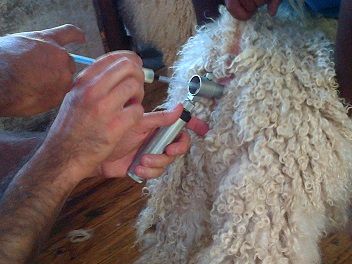Certainly, depositing semen into the reproductive tract of sheep for the purpose of artificial insemination (AI) can be described in a step-by-step process. AI in sheep allows for precise genetic selection and improved genetics without transporting animals long distances. Here’s a simplified overview of the process limited to under 500 words:
1. *Semen Collection*: Semen is generally collected from rams using an artificial vagina, electroejaculation, or through manual stimulation. The semen is then evaluated for quality, including concentration, motility, and morphology.
2. *Semen Preparation*: The collected semen can be used fresh, cooled, or frozen. If the semen is to be used at a location away from where it was collected, it may need to be extended with a diluent to maintain its viability, and then cooled or frozen in straws for transport.
3. *Estrus Synchronization*: Before insemination, the ewes are often synchronized in their estrus (heat) cycles using hormonal treatments (like progesterone sponges or CIDRs) so that they are receptive to insemination at the same time.

4. *Insemination Timing*: Timing of the insemination is crucial; it typically occurs towards the end of the estrus period when the ewe is most fertile, usually about 12-24 hours after the onset of estrus.
5. *Insemination Procedure*:
– The operator prepares the ewe, which may involve restraining her to ensure safety and ease of application.
– The operator wears gloves and may use a lubricant to facilitate entry of the insemination gun or pipette.
– The speculum is inserted into the vagina to visualize the cervix.
– Then, the insemination gun, loaded with a straw containing the semen, is gently passed through the cervix into the uterus.
– The semen is deposited into the uterine body or horn, depending on the method and preference of the operator.
6. *Care Post-Insemination*: After insemination, ewes may be monitored for any adverse reactions and are usually kept in a calm, comfortable environment to facilitate conception.
Post-insemination, the success of the procedure is monitored by checking for pregnancy, generally by using ultrasound, around one to two months after the insemination process.
It’s important to note that, depending on the law and regulation in the particular country or region, there might be specific guidelines and standards for artificial insemination in sheep that need to be adhered to.
The success of AI in sheep can vary based on the quality of the semen, the skill of the technician, the health and status of the ewes, and the timing of the insemination. It is a specialized procedure that should be carried out by trained personnel to ensure the welfare of the animals and to achieve the desired results.








